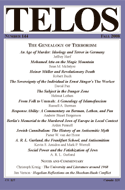Each Tuesday in the TELOSscope blog, we reach back into the archives and highlight an article whose critical insights continue to illuminate our thinking and challenge our assumptions. Today, Etel Sverdlov looks at Arden Pennell’s “Why Are They So Happy? Berlin’s Memorial to the Murdered Jews of Europe in Local Context,” from Telos 144 (Fall 2008).
 In all honesty, children playing under the shadow of the presidential statue in the Lincoln Memorial, sweethearts embracing behind the slabs of the World War II plaza, or families picnicking in the shade of the Vietnam Memorial, seem odd and incongruous. Monuments are rarely expected to act as recreational spaces. Rather, the heavy subject matter solemnified in each should lend to reflection and concentration. The opposite, however, is the case with the Berlin Memorial to the Murdered Jews of Europe, where the plaza filled with uniform rectangles of various heights provides visitors with a place to sunbathe, to cuddle, to play, to eat. In her article “Why Are They So Happy? Berlin’s Memorial to the Murdered Jews of Europe in Local Context,” from Telos 144 (Fall 2008), Arden Parnell examines the cultural history of the area in order to explain why the monument has been adopted and used with such unaccustomed cheerfulness.
In all honesty, children playing under the shadow of the presidential statue in the Lincoln Memorial, sweethearts embracing behind the slabs of the World War II plaza, or families picnicking in the shade of the Vietnam Memorial, seem odd and incongruous. Monuments are rarely expected to act as recreational spaces. Rather, the heavy subject matter solemnified in each should lend to reflection and concentration. The opposite, however, is the case with the Berlin Memorial to the Murdered Jews of Europe, where the plaza filled with uniform rectangles of various heights provides visitors with a place to sunbathe, to cuddle, to play, to eat. In her article “Why Are They So Happy? Berlin’s Memorial to the Murdered Jews of Europe in Local Context,” from Telos 144 (Fall 2008), Arden Parnell examines the cultural history of the area in order to explain why the monument has been adopted and used with such unaccustomed cheerfulness.
As the Berlin Wall rose and overshadowed both the western and eastern parts of the city, the neighboring streets and businesses began to lose their appeal. From 1961 onward, the focus of governments on both sides of the wall revolved around subtly deflecting notice from the areas that used to stand in the center of Berlin, but now formed the outskirts, due to the wall. Thus, Parnell explains, “The former center of town became a negative space on city maps.” As the country unified, both sides, disparate in their politics, economy, and culture, faced the difficult reality that one of the few things they held in common, was the same wall that caused their division. The “dead zone” around the wall, gave rise to new construction and a real estate boom, which caused ” ‘former’ Easterners . . . [to identify] this real estate transformation as the gloating triumph of one system over another.” This area, besieged by corporate construction, needed a new symbol of unity, as powerful as the wall, without the awful political ramifications. Lea Rosh provided the idea for a Memorial for the Murdered Jews of Europe. “Her call for a memorial was a suggestion to rebuild a shared vocabulary of commemorated suffering, starting in the spot that undoubtedly symbolized “suffering” to everyone. The plan that she put forth allowed the spot’s common history to continue, but with a gesture that belonged to neither East nor West, but to both.”
Perhaps, used to the solemnity of the Mall of America, it becomes easy to forget that what happened with the Memorial in Berlin does not represent an isolated occurrence. Architecturally, the structure holds aesthetic merit, and following the tradition of other grand monuments, even those concerning death, morbidity rarely sways visitors into avoiding it. For what are the Pyramids but huge headstones? Yet they are now intrinsically a defining part of Egypt. How closely do death and the Colosseum associate? Yet the structure is one of the most famous of ancient ruins. Even without the great engineering, people take pleasure in large memorials. Gettysburg, which proved the staging ground for one of the American Civil War’s bloodiest battles, now acts as picnic grounds and provides children’s programs. I do not know what leads some memorials to facilitate recreation while others promote meditation. Whether the public embraces a commemorative structure as a place for relaxation or solemnity is an issue that only time can resolve. Even Lea Rosh, when she lobbied the newly united German government to construct a memorial for the Murdered Jews of Europe, did not know how people would relate to it. The enthusiastic response thus spurs the question: if the point of a monument is to persist in memory, does the fact that it is an informal place really matter?
Read the full version of Arden Pennell’s “Why Are They So Happy? Berlin’s Memorial to the Murdered Jews of Europe in Local Context”at the TELOS Online website. If you are affiliated with an institution that is an online subscriber to Telos, you have free access to our complete online archive. If not, you can purchase 24-hour access to this and other Telos articles at the low rate of $5/article.








